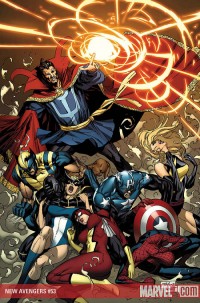NEW AVENGERS #53
What did the
iFanboy
community think?
Pulls
Size: pages
Price: 3.99
Honestly, it’d be a waste of time for me to try to put down an honest review of this one. I’m the guy who engaged in fairly useless and retrospectively humiliating arguments with friends on how the Defenders were obviously superior to the Avengers, not least because of how awesomely awesome the Son of Satan was. Needless to say me reviewing a Son of Satan Avengers issue written by the Marvel’s current Sorcerer Supreme, Mr. Bendis, would be an exercise in self-congratulatory masturbation; I mean sure it feels good, but is it really something to brag about?
Instead I’d prefer to provide some thrilling commentary on Bendis’ continued and seemingly increasing rejection of the one page comic format. And really, what could be more thrilling than a micro essay on panel-structure? Right? Right? Crap, you’ve already moved on to something else now, and I’m basically writing this for myself. Oh well, self-congratulatory masturbation it is then.
In a twenty-two page comic, Bendis elects to forego the one page structure that has dominated the medium for 70 or so years by providing paneled double page spreads on eight pages or over a third of the book. In fact, thanks to commercial interruptions, there aren’t two independent facing pages until page 17; there are actually only two instances of independent facing pages in the whole book, both of which come late (17-18 and 20-21). To contrast this, Gail Simone’s Secret Six #9, which I fawningly reviewed a few weeks ago, features eight independent facing pages and no double page spreads, paneled or otherwise. Looking back at main stream super-hero comics, paneled two page spreads were very rare a decade ago and basically didn’t exist two decades ago.
Anyone who’s been following Bendis knows this is no aberration. Bendis has used paneled two-spread page throughout his career. From a brief and likely incomplete survey of his work, and as demonstrated in this issue, Bendis prefers this structure to supplement the first acts in his works, providing a great deal of his famously infamous talky exposition pages in facing two page spreads. His use of panels on these pages varies significantly throughout his opus reflecting the same variation of set-up he uses with paneled single pages, suggesting that he has largely normalized this method and basically paints a two page canvas the way he’d paint a one pager.
This technique has two obvious draw backs. First, it cuts the artwork in half. Both in trade and floppy, the overall picture cannot be enjoyed as originally constructed due to an insidious fold insisting on slicing through our already struggling heroes (poor son of Satan seems to be yelping from a staple in his armpit on page 11-12). Second—and I hesitate to highlight my own dumbness here, preferring it to come across more subtly—it can cause you (read dumb me) to get lost when it is not always apparent whether you should move on to the right or step down to the next row.
That said, the overall impact of the technique can be stunning (think PI interview scenes in Alias, or the sex scene in Powers 25, or, more mundanely, page 1-2 here where the panels give a sense of the cramped conversation aboard the Quinjet). Like most variations from the typical comic, the power of the technique is derived from its contrast to the expected single page, gridded paneling we expect from comics. As is with music, comic art derives drama from creating a base vocabulary and then suddenly and violently tearing away from this base, surprising the senses only by first lulling them. The paneled double page can be shocking, and this shock can mirror the shock of the characters prancing across the fold, creating a delightful connection between the story and the medium.
Though I giddily and frequently worship at the alter of Bendis, I would caution him to keep the power of this tension in mind as he divinely dolls out doses of this technique. As is the case in this issue, overuse of this format causes it to become the base of the comic structure itself rather than the variant. As such, we are left with a comic founded on a flawed system that battles with staples and spines rather than one that cooperates with these publishing impediments and only vary with this cooperation to produce proper effects. Such comics lose their interest and start to come off as, well, self-congratulatory masturbation.
–T. King
Art: 4 - Very Good




Leave a Comment
Login or Register to get involved and leave a comment